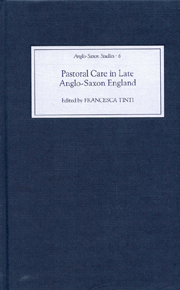Book contents
- Frontmatter
- Contents
- List of illustrations
- List of contributors
- Abbreviations
- Introduction
- 1 The clergy in English dioceses c. 900–c. 1066
- 2 The ‘costs’ of pastoral care: church dues in late Anglo-Saxon England
- 3 Ælfric in Dorset and the landscape of pastoral care
- 4 Is there any evidence for the liturgy of parish churches in late Anglo-Saxon England? The Red Book of Darley and the status of Old English
- 5 Remedies for ‘great transgressions’: penance and excommunication in late Anglo-Saxon England
- 6 The pastoral contract in late Anglo-Saxon England: priest and parishioner in Oxford, Bodleian Library, MS Laud Miscellaneous 482
- 7 Caring for the dead in late Anglo-Saxon England
- Index
1 - The clergy in English dioceses c. 900–c. 1066
Published online by Cambridge University Press: 12 September 2012
- Frontmatter
- Contents
- List of illustrations
- List of contributors
- Abbreviations
- Introduction
- 1 The clergy in English dioceses c. 900–c. 1066
- 2 The ‘costs’ of pastoral care: church dues in late Anglo-Saxon England
- 3 Ælfric in Dorset and the landscape of pastoral care
- 4 Is there any evidence for the liturgy of parish churches in late Anglo-Saxon England? The Red Book of Darley and the status of Old English
- 5 Remedies for ‘great transgressions’: penance and excommunication in late Anglo-Saxon England
- 6 The pastoral contract in late Anglo-Saxon England: priest and parishioner in Oxford, Bodleian Library, MS Laud Miscellaneous 482
- 7 Caring for the dead in late Anglo-Saxon England
- Index
Summary
Now at that time there were in the Old Minster, where the bishop's throne is situated, cathedral canons involved in wicked and scandalous behaviour, victims of pride, insolence and riotous living to such a degree that some of them did not think fit to celebrate mass in due order. They married wives illicitly, divorced them, and took others; they were constantly given to gourmandizing and drunkenness. The holy man Æthelwold would not tolerate it.
The clergy of late Anglo-Saxon England have not received the most favourable of presses, as the quotation above shows. Too often they are defined for us by the much more literate monks of the Benedictine reform movement, who, although they formed only a small part of the late Anglo-Saxon ecclesiastical establishment, set the tone and the agenda for the rest from the reign of Edgar onwards. More problematic for the historian of the clergy is that they have not been recorded for us in sufficient detail. For the historian of the later Middle Ages, that is to say of the period from the Fourth Lateran Council of 1215 onwards, the standard approach to the clergy is a prosopographical one, made possible by the existence of enough pieces of information to supply biographical outlines for large numbers of individual clerics. Since the 1960s scholars have been steadily producing detailed lists of later medieval clergy in Britain – English cathedral canons between 1066 and 1540, graduates of Oxford and Cambridge, Yorkshire parish clergy and Scottish higher clergy and university graduates.
- Type
- Chapter
- Information
- Pastoral Care in Late Anglo-Saxon England , pp. 17 - 26Publisher: Boydell & BrewerPrint publication year: 2005



